When browsing through collections of old family photographs it’s not unusual to come across images of unknown people and places. But how do you discover who these nameless ancestors are?
One method is to work out when the photograph was taken – once you have a rough time frame, you can compare the details of the sitter to ancestors in your family tree and hopefully find a match. This can be a complicated task, but every family historian likes a good challenge!
Let’s take a look at some of the key methods used for dating photographs, including: determining the photographic process and format used; researching the photographers details; identifying the fashion styles of a particular era, and looking for visual clues in the studio setting and the composition of the photograph.
The photographic format
Several distinct photographic processes were created in the 19th century, so by analysing the format of the photograph and the process used, you should be able to work out a rough time period. Some of the main photographic processes of the 19th century include:
Daguerreotype 1839 – 1860
Invented by Louis Daguerre in 1839, the Daguerreotype was the first commercially successful photographic process. In 1845, Australia’s first professional photographer George Goodman briefly ran a studio in Melbourne where these luxury items could be had for the price of one guinea and came encased in ‘a handsome gilt and morocco case’.1
The Daguerreotype features a negative image on a mirror-like metal surface, which reflects a positive image. If you tilt the image it will display as either a positive or a negative, depending on the angle of the tilt. The metal surface is often silver plated and normally kept under glass, but if the metal has been exposed to air there may be signs of tarnishing around the edges. Because they were so delicate, daguerreotypes were protected by glass and usually housed in leather cases, lined with velvet or silk.2
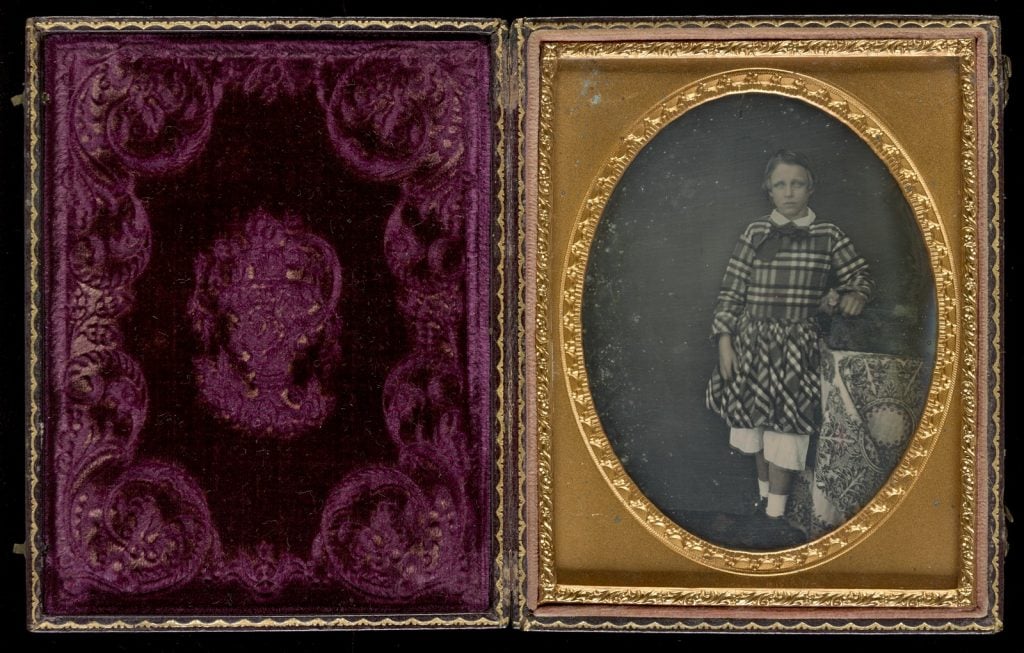
Calotype 1841 – 1860
The Calotype or Talbotype was patented by William Henry Fox Talbot in 1841 and usually features a salted paper print taken from a paper or glass negative. This process allowed for many copies to be made from one negative. Images are often quite mottled and grainy, although images taken from a glass negative are noticeably sharper. The paper print has the roughness of good quality writing paper, with a matte finish.3 Prints would have originally been warm brown in tone but, as they deteriorated, may have developed a yellowish-brown tinge, foxing (spots and browning) or faded marks.

Ambrotype 1855 – 1865
Invented in 1852, the Ambrotype is a glass negative that has been backed with lacquer, paint, cloth or paper to show a positive image. They were similar to daguerreotypes, but were far more affordable and faster to produce, and unlike a daguerreotype, when you tilt an ambrotype it always appears as a positive. The images can be sharp and clear but the highlights may appear dull and grey, rather than white.4 If the backing has deteriorated you might see areas of exposed glass. Some ambrotypes were housed in leather and silk lined cases, in paper or card casings or in Union Cases – an early form of plastic.
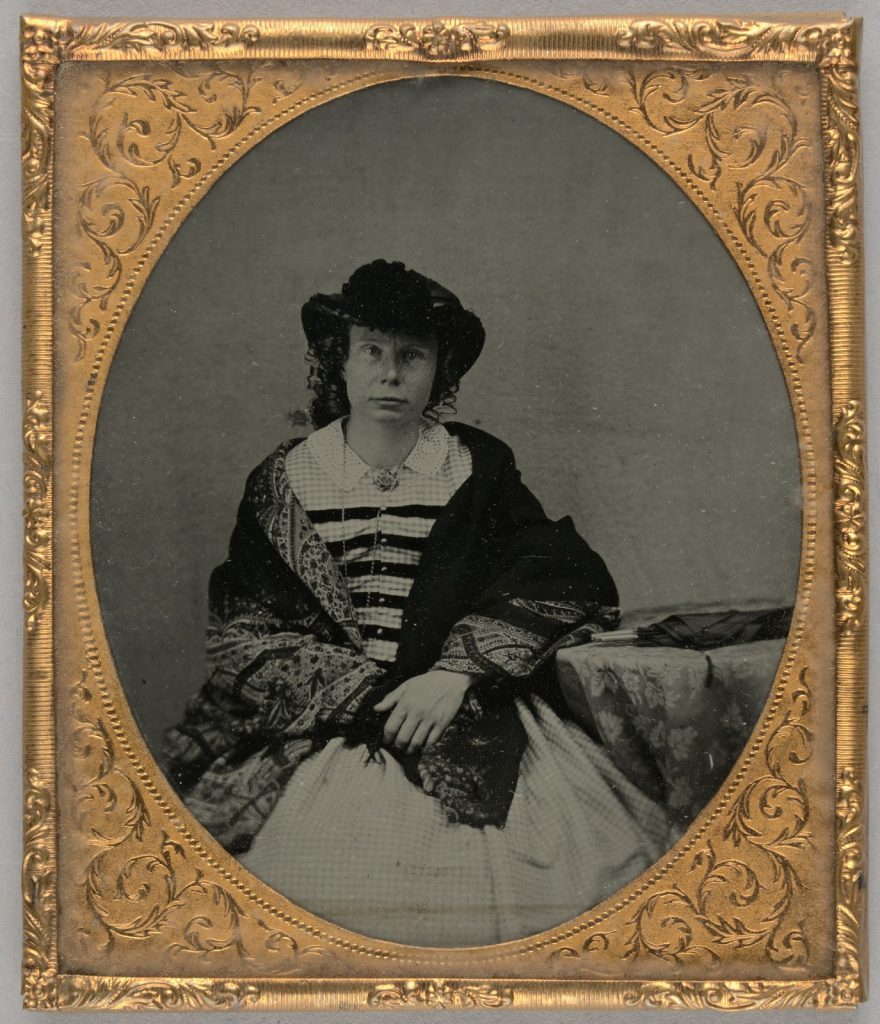
ca. 1860; H98.55/4
Tintype 1850s – early 1900s
Also known as a Ferrotype, the Tintype was first produced in 1856 and remained popular until the late 19th century. A photographic emulsion was added to a thin metal plate, usually iron, which had been coated with dark enamel or lacquer – this produced a positive image. Cheap and quick to produce, they were popular with itinerant photographers who would travel to regional towns, set up temporary studios and produce photographs in minutes. `Gem’ photographs are tintypes produced in ‘postage stamp’ size. Although some tintypes were housed in leather cases, most were stored in paper sleeves or photo albums which had been cut specifically to house the smaller images.5
Tintypes usually have a dark grey background quite similar to the images seen in Ambrotypes. Because the tintype is on a magnetic plate you can identify the format by running a magnet over the back of the plate. As they were often made of iron, there may be signs of rust on the surface of the plate.
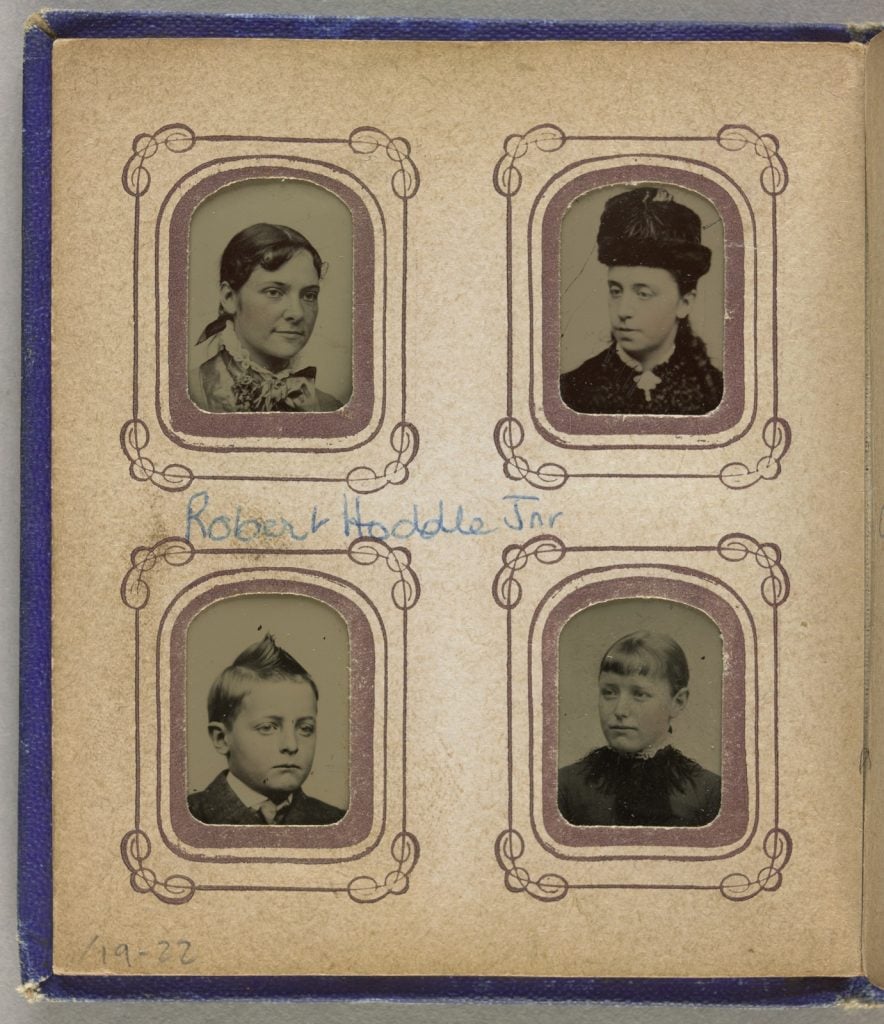

Albumen print 1850s – early 1900s
Albumen prints were the most common and commercially successful form of 19th century photography. Prints were made on very thin paper, coated with a layer of egg-white (albumen) and salt, and then sensitized with a solution of silver nitrate solution.6
Usually a soft sepia colour, they are characterised by a smooth appearance with either a shiny or semi-matte finish. Because the paper was so thin, prints were usually mounted on a heavy backing sheet. Images which have deteriorated would show signs of foxing (spots and browning) or faded marks. Albumen prints were often presented as carte de visite or cabinet photographs.
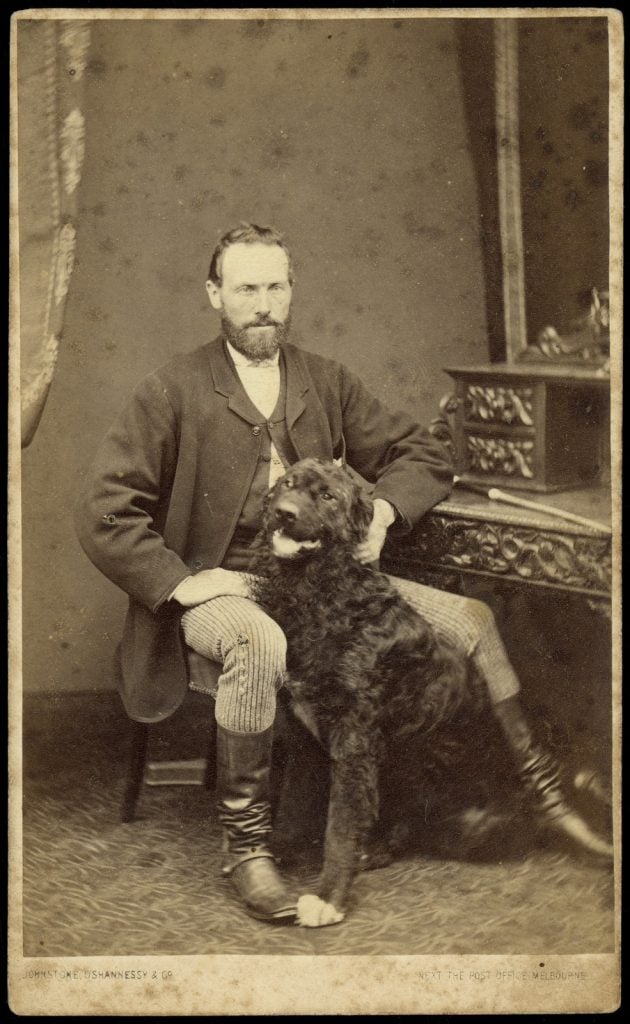
Carte de visite 1859 – early 1900s
The photographer William Blackwood introduced the carte de visite to Australia in 1859.7 Multiple copies of photographs could be produced and mounted onto cards, usually measuring around 6 cm by 10 cm. Early mounts were thin, square cut cards, pale in colour and quite plain. By the 1880’s they were being produced on thicker, dark coloured cards, often with bevelled edges. The photographer’s details started to appear on the mount by the 1860s and over time, the mounts began to feature more elaborate designs and embellishments.8 A carte de visite was a highly desirable item, which would often be exchanged with family and friends and stored in specially designed albums. A fine example of such an album can be found in Lucy Coppin, a birthday present from her loving children [Album of portraits of George Coppin, family and friends].

Cabinet cards 1866 – early 1900s
Cabinet cards were produced in the same way as a carte de visite but can be easily identified by their larger size – usually measuring around 16 cm x 10 cm. Because of their size they were often displayed in cabinets, rather than in albums.

The photographer’s details
Many photographs feature the name of the photographer or studio; you can use this information to find out exactly when the business operated. A list of 19th century Australian photographic studios and the dates they existed appears in the publication Australians behind the camera, directory of early Australian photographers, 1841-1945. See also The mechanical eye in Australia: photography 1841-1900, which contains an index of photographers. The Sands and McDougall directory is an excellent tool for verifying when and where a studio existed and the Trove newspaper database can be used to search for newspaper advertisements – to confirm dates and locations.
Researching photographers
Is the photographer’s name printed or otherwise noted on the photo? If yes, then you can try and find the photographer in our catalogue, in the books Australians behind the camera, Their birth and death dates, or dates and place of operation can also help you to get a rough idea of when the photo was taken.
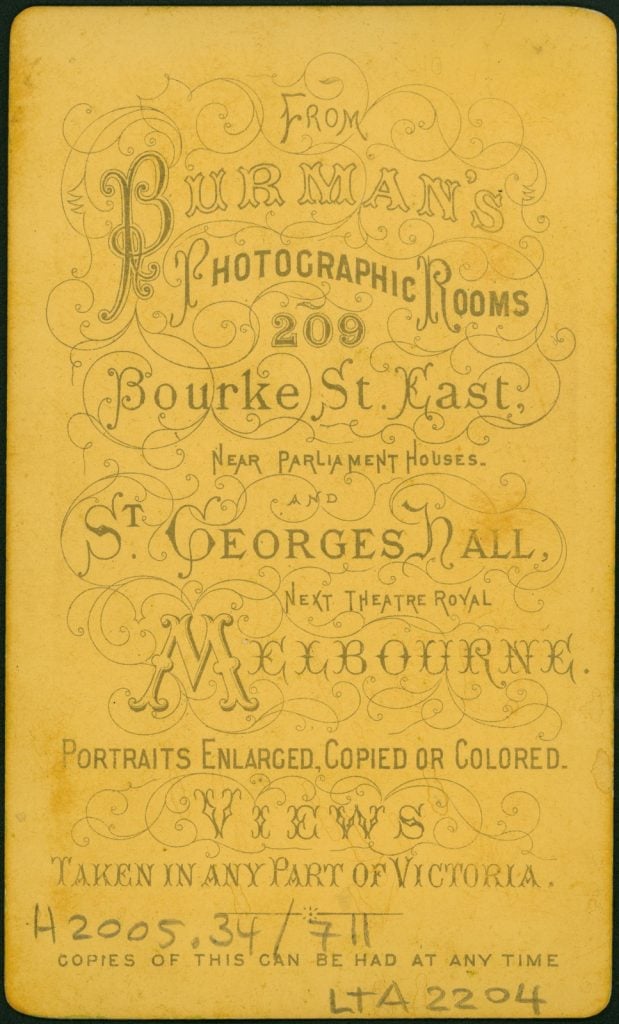
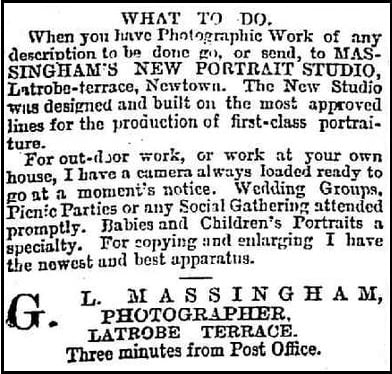
The studio setting
Once you’ve identified the format of the photograph you can gather additional clues from the studio setting and composition of the photograph.
Early studio photographs featured simple sets, usually with plain backgrounds. Because the daguerreotype and ambrotype required long exposure times, the sitter was required to keep perfectly still, often using a chair or table as a support. Posing or support stands were also used, and can occasionally be seen in the photograph (see the image of the gentleman below). Initially, close up, half length and three quarter length photographs were favoured, but by the 1860’s the full length pose became more popular, giving people the opportunity to show off their fine clothing.9
In the 1860s, studios incorporated drapery into their sets and introduced a range of classical props, such as plinths, columns and balustrades. By the 1870s, more ornate pieces of furniture were featured, such as velvet couches, and the half length and three quarter length images became popular once more.10 Painted backdrops were favoured, and by the 1880’s they were used with additional props to create highly desirable rustic settings. In the 1890s the head and shoulders or vignette style become one of the most popular styles of the decade.11
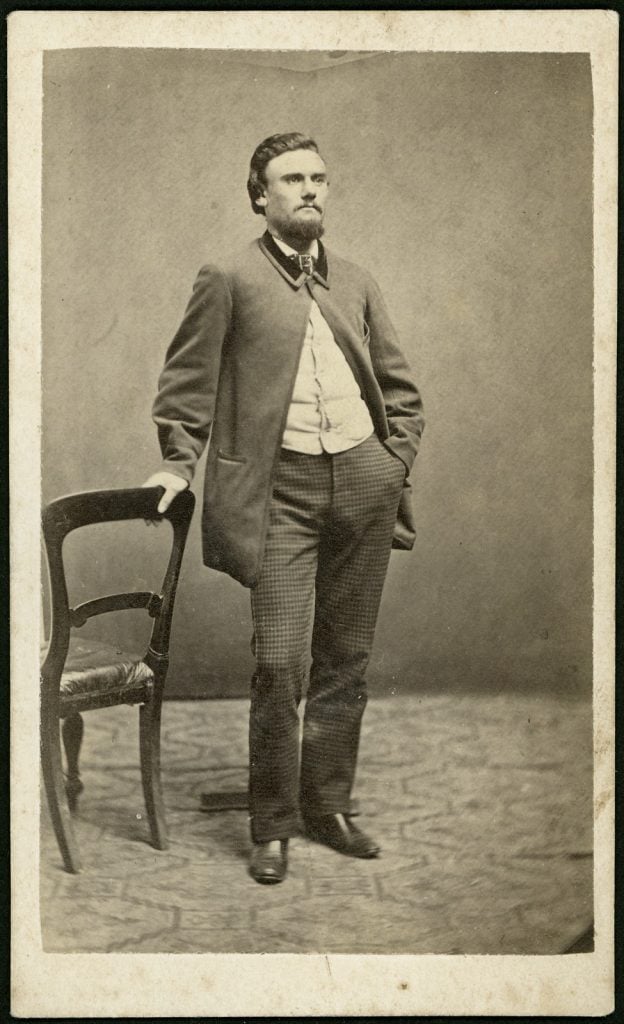
ca. 1863 – ca. 1866; H2005.34/2225
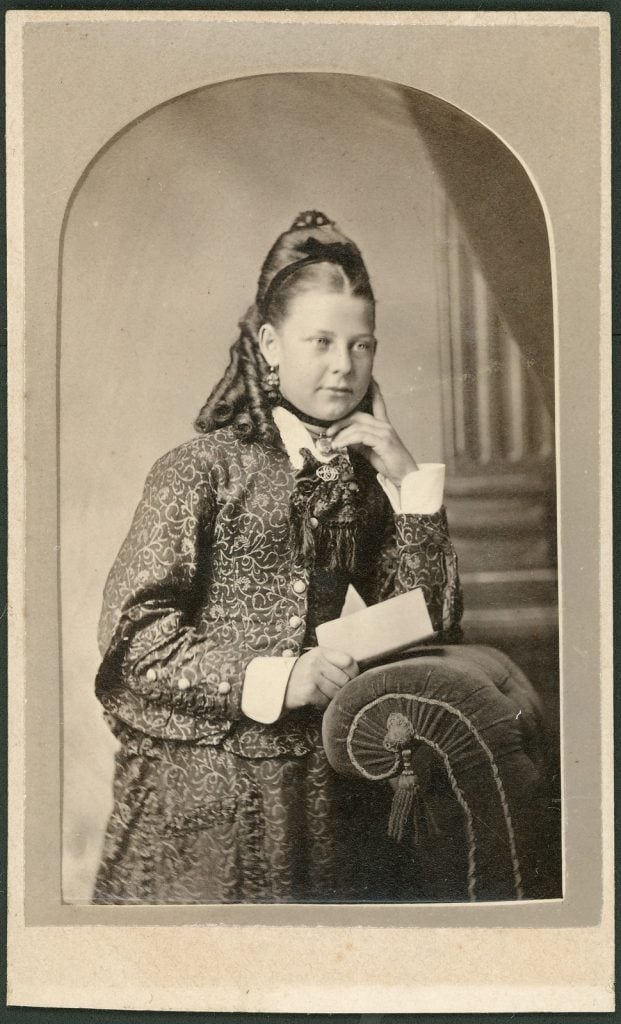
ca. 1870 – ca. 1879; H2005.36/69
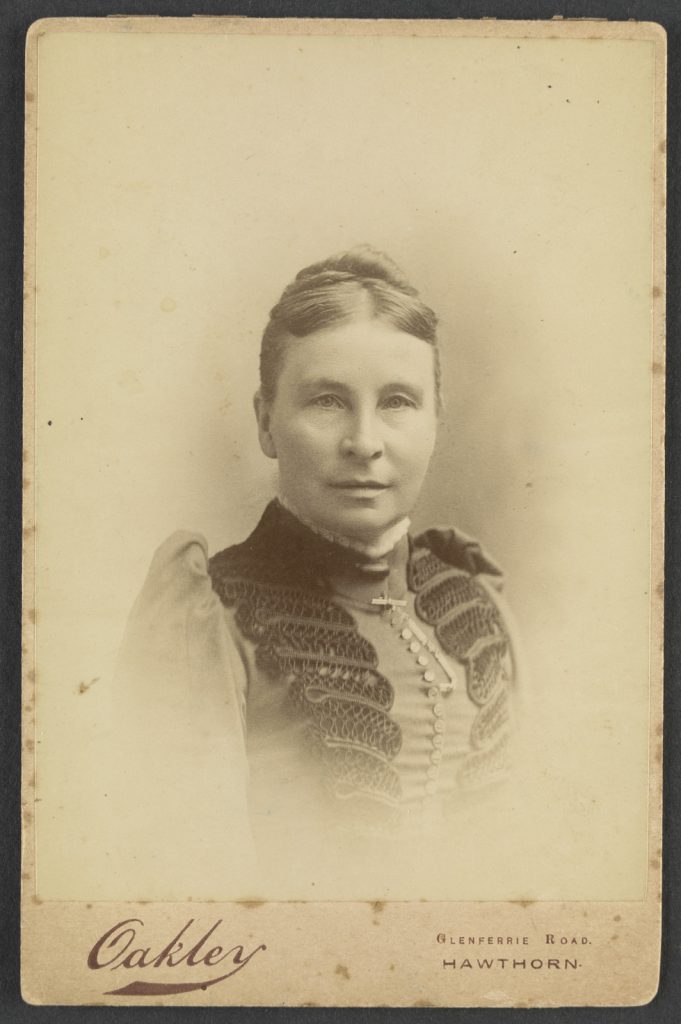
Fashion
Evaluating the clothes worn by the sitter and comparing them to the fashions of a particular era is another useful way of dating an image.
In the 1840s women favoured wide dresses with skirts supported by layers of petticoats. In the 1850s crinoline frames replaced the heavy petticoats and allowed the skirt to be even more voluminous, featuring tight fitting bodices. Hairstyles were quite plain, with the hair often pulled back into a bun, covering the ears and with a middle parting. From the mid 1860s skirts began to recede in diameter and became flatter at the front but more pronounced at the back – this style was eventually replaced by the bustle.12 Dress designs of the 1870’s became more ornate, with high necklines and trimmings of lace, ribbons and fringes. The chignon hairstyle of the 1860’s was replaced by more elaborate hairstyles. In the 1880s clothes became plainer with tight corsetry, narrow sleeves and close fitting bodices. The `Princess line’ style was fashionable, creating a long waisted, natural look. Hats were highly elaborate, featuring trimmings of lace, fur and velvet. The early 1890s saw the introduction of ‘leg of mutton’ sleeves, tailored suits with dress bodices and simpler skirt designs.13
Male clothing is difficult to date as changes in tailoring were more subtle. In the 1850s men started wearing tailless coats that were loose fitting and fastened by a top button. Dark jackets were commonly worn with light trousers. Lounge suits became popular in the 1860s and by the 1870s all three pieces of the suit matched in colour.14 Top hats were popular until the 1870s when they were replaced by the bowler hat. Cravats were replaced by ties in the 1870s. Facial hair was a common feature in 19th century Australia; however by the 1880s beards began to be replaced by moustaches.15
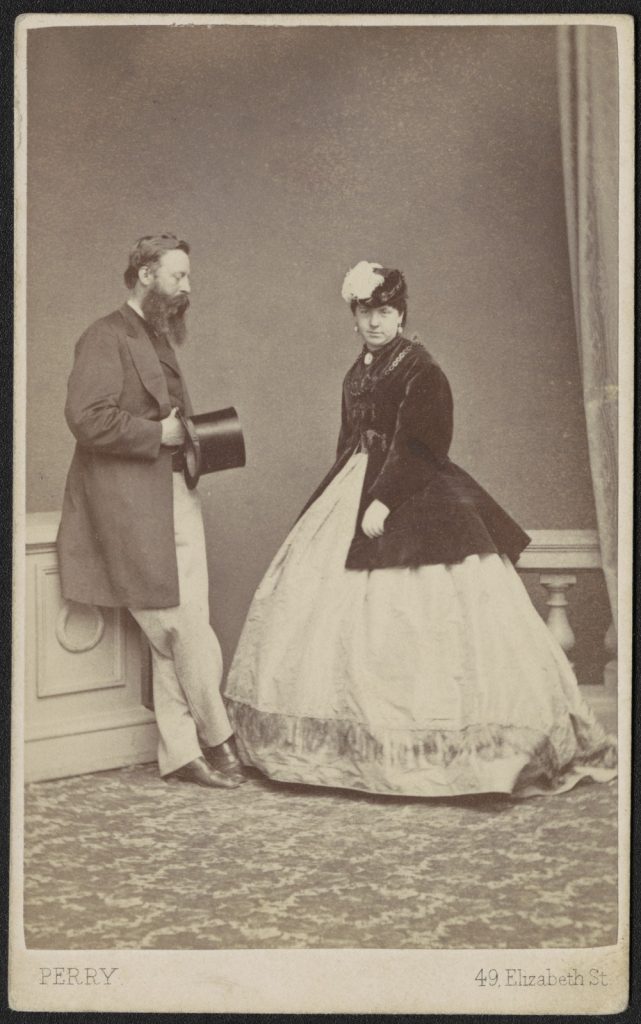
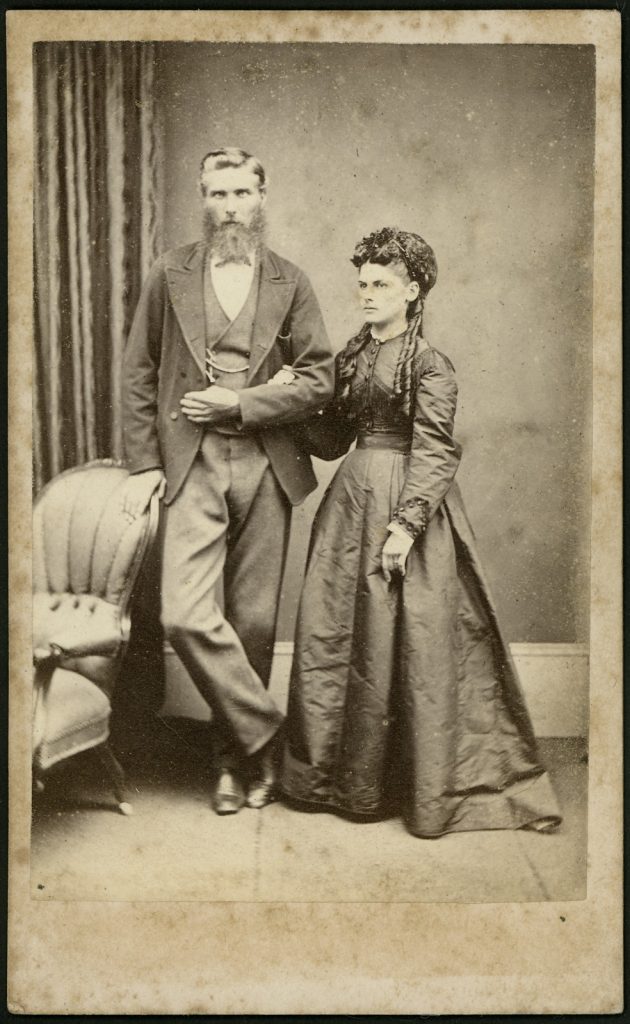
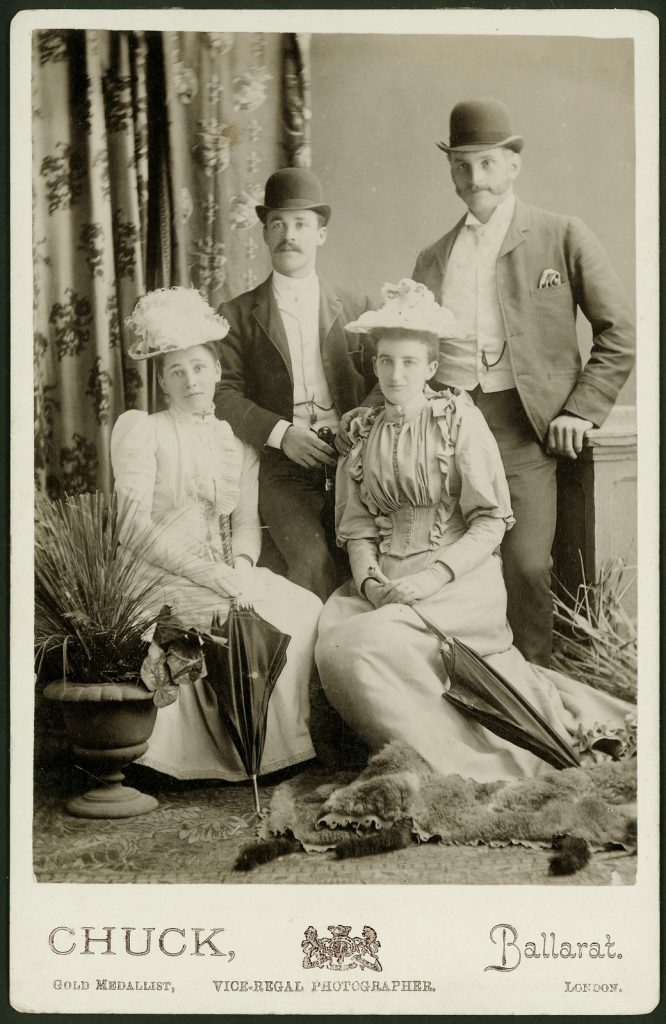
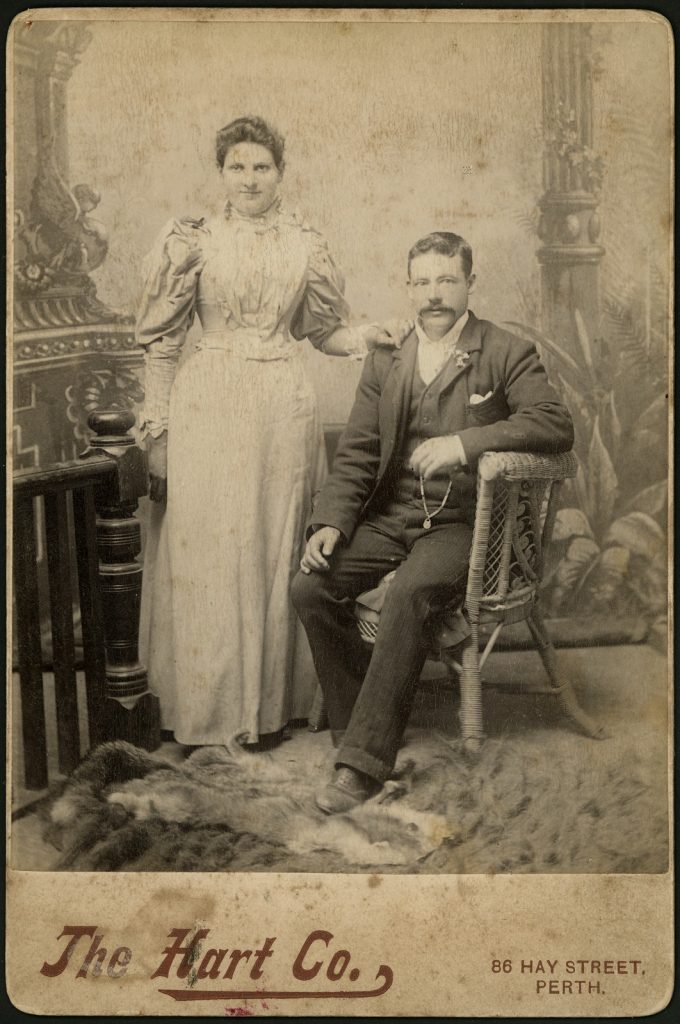
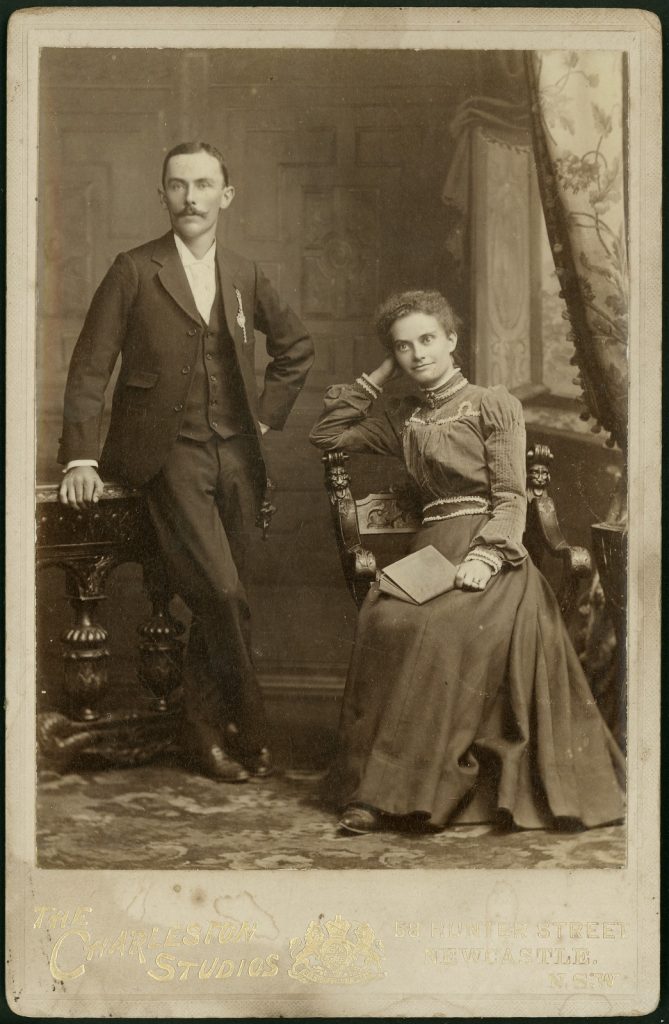
1899; H2005.34/821
More detailed information on 19th century fashion can be found in the following resources:
- Australian Dress Register, features a timeline of Australian clothing from 1870 onward.
- Harper’s Bazaar Archive (1867— ) provides access to digitised copies of this fashion magazine. Browse through issues to find illustrations of the fashions from a particular decade. (available to State Library Victoria members who are Victorian residents).
- Jayne Shrimpton. (2020). Fashion and Family History: Interpreting How Your Ancestors Dressed [ebook].
- The State Library’s Fashion research guide will help you to locate material on many aspects of fashion.
- Victoria and Albert Museum – History of fashion 1840-1900
When evaluating fashion styles keep in mind that in the 19th century having a photograph taken was a very special event, so people would often wear their finest clothes or `Sunday best’. For many people this outfit could have been used over many years. Also, when comparing Australian fashion styles to overseas fashion trends, it’s important to know that Australian fashions were often 2-5 years behind international trends.
Where next?
Once you have established the era in which the photograph was taken, you can move on and research your ancestors who lived at that particular time. If you haven’t researched your 19th century ancestors, we recommend you view our Researching your Victorian ancestors research guide which lists many of the family history resources ideal for researching your ancestors.
In the Newspapers and Family History Reading Rooms, you will find many publications on dating photographs, including material on dating outdoor locations and 20th century images. Here are a few that we recommend.
- Davies, A., Stanbury, P., & Tanre, C., 1985, The mechanical eye in Australia : photography 1841-1900.
- Frost, L., 1991, Dating family photos 1850-1920
- Juaney, G., 2001, Identifying and dating 19th century family photographs
- Pols, R., 2016, Dating old photographs, 1840-1950
- Pols, R.,, 2005. Dating twentieth century photographs.
- Shrimpton, J., 2008, Family photographs & how to date them
- Shrimpton, J., 2014. Tracing your ancestors through family photographs,
- Tanre, C., 1977, The mechanical eye in Australia : photography 1841-1900
- Taylor, M.A., 2013, Family photo detective
See also
Valverde, M, F, Photographic Negatives: Nature and Evolution of Processes (online PDF), 2nd ed, Advanced Residency Program in Photograph Conservation, New York.
References
- The Melbourne Courier 6 August, 1845, p.3
- Shrimpton, J., 2014. Tracing your ancestors through family photographs p.2.
- Tanre, C,,1977, The mechanical eye in Australia : photography 1841-1900, p. 71.
- Pols, R., 2016. Dating old photographs, 1840-1950, p. 7.
- Tanre, C., 1977 The mechanical eye in Australia : photography 1841-1900 p. 73.
- National Portrait Gallery – Albumen prints, viewed 14 June 2021
- Design & Art Australia Online – William Blackwood, viewed 14 June 2021.
- Tanre, C., 1977, The mechanical eye in Australia : photography 1841-1900, p. 74.
- Pols, R., 2016. Dating old photographs, 1840-1950, p. 44.
- Shrimpton, J., 2014. Tracing your ancestors through family photographs pp 31-37.
- Pols, R., 2016. Dating old photographs, 1840-1950, pp. 44-45.
- Shrimpton, J., 2014. Tracing your ancestors through family photographs pp 31-37.
- Pols, R., 2016. Dating old photographs, 1840-1950, pp. 51-52.
- Shrimpton, J., 2014. Tracing your ancestors through family photographs pp 31-37.
- Tanre, C., 1977, The mechanical eye in Australia : photography 1841-1900, p. 77.

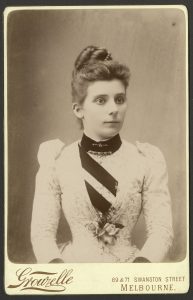
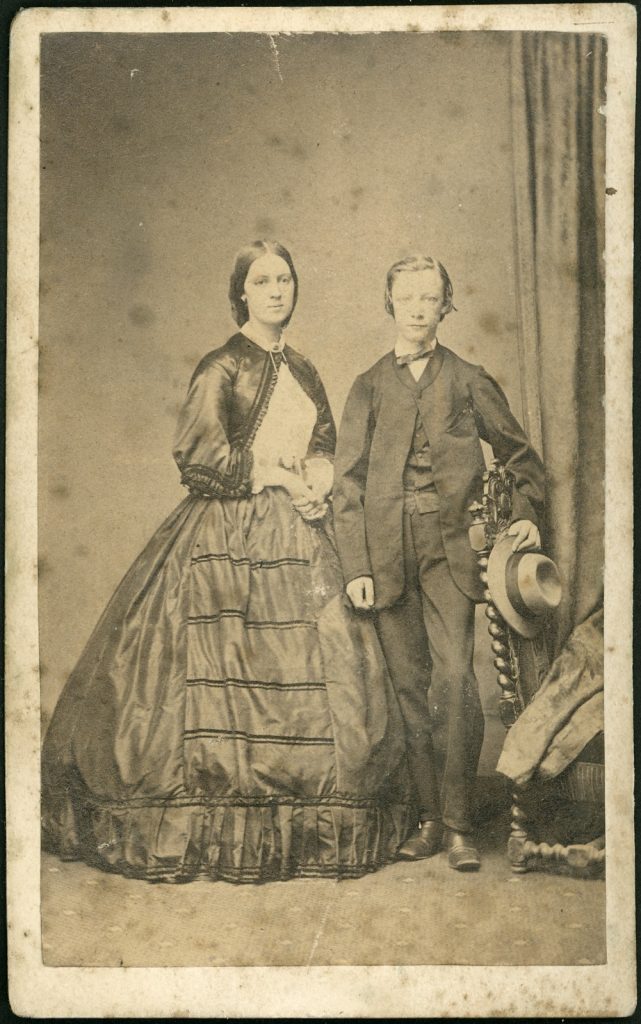

Very interesting and not something I had thought about. Thank you.
Very interesting article. I appreciate the focus in on family tree searches in Victoria, but I’m wondering whether you have any suggestions about pursuing genealogical inquiries in France? Specifically related to a family member who was in the French resistance?
Thank you Juliette. The FamilySearch website has produced an excellent Research Wiki, which provides genealogical information for most countries. By going to the page for France you will find guides on how to get started and links to many key family history resources. There’s even a map of France, which allows you to click on a region and find more specific information. Kind regards, Ann
Thank you for such a comprehensive guide. I am re-visitng my heritage photos!
Just the information I was seeking. Thank you
An excellent summary
This is very interesting and most informative, thank you!
Thanks for the info. I think I have a Daguerreotype with a bit of damage. Do you know where I can take it to get it restored or copied so I can see it properly?
Hi Sue. There are many places that provide photo restoration services, but I’m not sure if that would include Daguerreotypes. If you do an internet search using the keywords Daguerreotype restoration Australia, you will find the names of a couple of places. Talk to them about the type of restoration work they provide. Kind regards, Ann
Fascinating information. I wonder if a particular piece of jewellery – like a cameo or bar brooch – would also help date a photo? The various photographic techniques mentioned are really interesting and some old photos we have are worth having another look at to determine age. Thank you.
Thank you Mary, I’m glad that you enjoyed the blog. Jewellery would definitely help to date an image. Cameo’s, mourning jewellery and the use of particular stones and materials may help to identify a particular era. There are tips on using jewellery (and hairstyles) in some of the books listed in the blog. Kind regards Ann
Thank you. This information will be very useful.
Wonderful information, thank you.
Wonderful information especially as I have lots of early family photos, with reference to some of these early photographers
A very interesting and helpful article for family history research. Photos can reveal a lot of information relevant to family stories.
I have been using the reading room, doing research.
The info is this blog will assist me in the next stage of research.
Many thanks
Very enjoyable article, I wonder though if you considered that the child in the tartan dress portrayed in the daguerreotype might be a boy rather than a girl, it was quite usual in the Victorian era for boys to wear dresses up to a certain age.
Thanks Thomas. Yes you’re quite right. It is possible that the child is a boy. I’ll pass your comments on to our Pictures staff. Kind regards, Ann
I received quite a few photos a couple of years ago and this very informative information will help in many ways. Thank you so much for all you have shared.
It’s a fascinating topic that I hadn’t considered before. Thank you very much.
Use census records and voter lists to see where families with the Nameless surname lived.
Yes, there are a number of family history resources available that can be used to research a known surname. Our Researching your Victorian ancestors research guides lists many of these resources. Kind regards, Ann
I really liked the photographic format idea. Through this, we can get an idea of what’s the year the photograph was taken.
Thanks for sharing this.
I have just finished a book of family history based on a photograph album made by my father-in-law with snaps he took on a trip to America in 1923. The condition of the photos vary from good to very poor. Given the lack of information, apart from carefully notated headings in the first 50 or so pages, the book was destined for a skip without some intervention. Without the information you present at hand I fell upon some of the strategy by chance. The most difficult job I found was identifying what became of the individuals named. For instance let’s say, Fred Williams was named, I could find no way to identify him and record what may have become of him. So my work is incomplete leaving others to finish it. Nevertheless, your work would have saved me many hours of enjoyable discovery. Thank you.
Thanks so much for your kind comments Bruce. Congratulations on completing your family history book and on persevering with your photographic research. What a great achievement. Kind regards Ann
Hi Bruce. Thank you so much for your comments and well done on completing your family history book. What an achievement! All the best, Ann.
Fantastic article, thank you. You have inspired me to investigate numerous photos of people unknown to me, and as for the dating from the fashion of the time, this will help my genealogical research immensely.
Thanks so much Jente. I hope you have great success with your research. All the best, Ann
Really interesting article. I am wondering if the dates mentioned are relevant to England or specifically Australia. i.e how closely did Australian inovation and fashion follow England?
Hi Graham. I’d use the dates as a rough estimate but also extend the period by 2-3 years. Our distance from Europe would probably mean that it would take a year or two for fashions to make their way here. All the best, Ann.
Great read and a “keeper”. Questions on this subject appear often and now we can refer people to your very insightful article. Thank you!
Hi Ann and thank you for your assistance, your article is an inspiration .. I have been sleuthing family portrait photographs from the late 1800s but I am a bit stumped by a portrait in a very old frame hanging on a wall….
It looks photographic, and when I (very carefully) took her from the frame and looked in vain for clues, I found nothing except a scrawled 4 digit number and I think the word “Fitzroy”… probably framer’s notes I reckon…. anyway…
She measures approx 460×350, black and white, matte, almost chalky finish, printed (or maybe backed) on heavy card. Dressed c 1890. Now the question….what sort of technology was there to produce something of this size?
Hi Alan, thanks so much for your message. I spoke to a colleague who is one of the library’s Collection Curators and she sent me the following, very informative reply –
“Not sure if this is an albumen print or gelatin silver print. There are three possible options. Most albumen photos and by the 1890s gelatin silver prints were created by copy printing (contact printing) a negative onto sensitised paper i.e. usually prints of this period have the exact size of the camera produced negative, often a glass plate negative. So in this instance the camera may have been a large format camera using large format glass plate negative. However some photographers used very simple enlargers, known as solar enlarging cameras, as they relied on the sun, by the 1890s artificial light sources were used, limelight, magnesium and electric light bulb to produce enlargements from enlarging cameras. And depending on the date a trade printer in the early 20th century could have printed the image from a large format glass plate negative onto photographic paper from a commercial size roll of paper.
I hope this answers your question. Kind regards, Ann